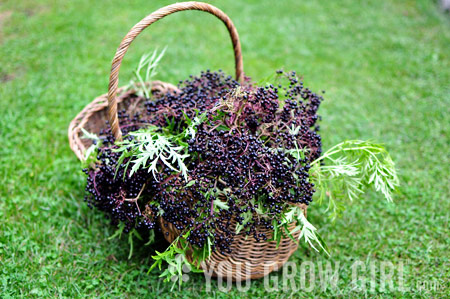
My friend Barry has an elderberry tree in his yard. Last summer he offered up the harvest in exchange for a sampling of the end product. I collected a lot of berries and was a bit unsure about what to do with them. Raw elderberries have a somewhat unpleasant scent and are not edible so it was difficult to commit to a usage without a clear understanding of what I was getting into.
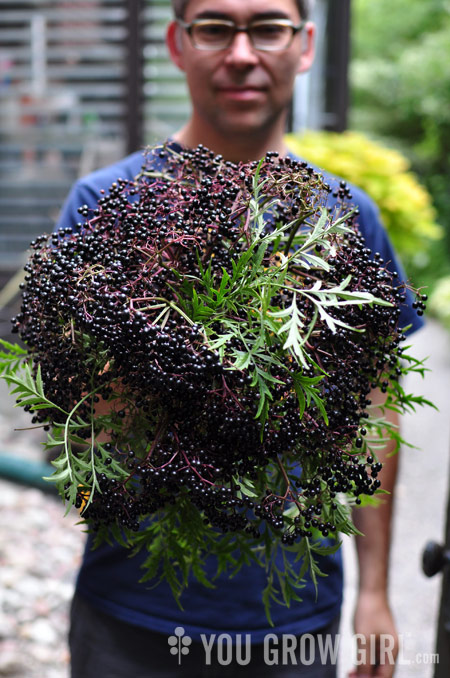
[Please note that while there are elderberries leaves shown in this photo, you should not eat them. They are poisonous!]
In the end, I made cordial. It was pretty good. The berries have an earthy taste. That’s all I can come up with as a descriptor. Earthy. Perhaps a bit pungent. It does taste like berries, I just can’t place a finger on which berries exactly. We dripped it on pancakes, poured a little onto granola and yogurt, and added it to sparkling water on occasion. Elderberries are very high in vitamin C and potassium. Many people use the cordial as a cold and flu elixir, instead of store-bought pharmaceutical cough remedies.
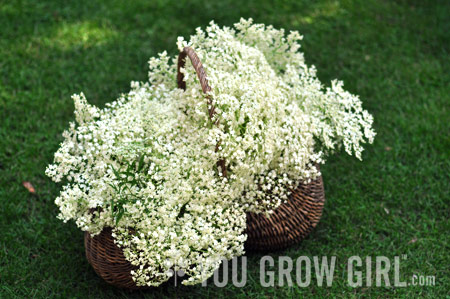
This year I wanted to try using the flowers so I harvested about two thirds of the tree back in June, when the flowers were in season, and left the remainder to develop berries. I had enough to make two batches, so I tried two different methods. Unfortunately, I no longer remember the second (preferred) method nor can I recall what it was that I did or didn’t do that made it better. However, if you’re interested, the first, less preferred method came from the River Cottage Handbook No.2: Preserves, by Pam Corbin.
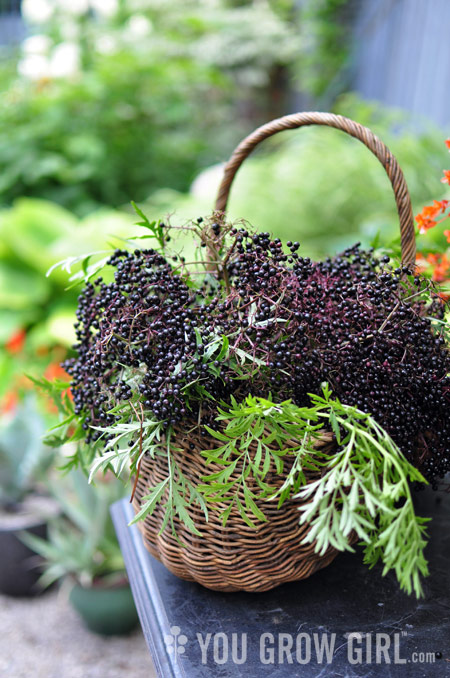
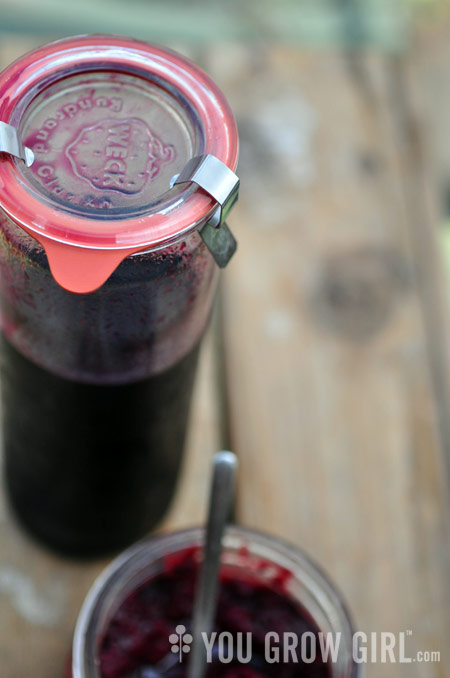
This year, with only 1/3 the harvest, I made a much smaller batch of cordial, which is fine by me because I think we prefer the elderflower flavor. I have no memory of how I made it last year, but this year I used this recipe from David Lebovitz’s website. Within the notes he makes a remark about straining the cordial a second time through a fine sieve. I’ve found that step to be essential and not overly attentive. Otherwise you end up with a very seedy, crunchy syrup. I didn’t have enough to can so I just sterilized two jars on a low heat in the oven before filling, gave one to Barry, and refrigerated the other.
I also made a quick, single jar batch of mixed berry jam last weekend (pictured). But that’s another story.
———
p.s. The site will be down this weekend while we switch over to a new design and work out all of the inevitable kinks. It’s going to be a bit manic, but I’m so excited! A big change has been a long time coming.
I used to make black raspberry, blackberry, and then elderberry jellies (in the order they come ripe). Over the years, I noticed we always had elderberry and blackberry jelly leftover, but the black raspberry ran out early in the year.
So… now I try to harvest 3 times as many black raspberries, and I let the blackberries and elderberries alone.
My grandmother used to make elderberry dumplings, but to me they weren’t edible. The dumplings were good, and the berries tasted OK, but the seeds were like wood chips in the mix.
Your post brought back a lot of memories…
Ooooh! So jealous! I LOVE elderberries and flowers :)
St. Germain Elderflower Liqueur! Beautiful bottle and a taste that will send you out of your head in ecstasy.
What did you make with the flowers?
Amy Karol (of the Angry Chicken blog) uses them in a homemade cough syrup: http://angrychicken.typepad.com/angry_chicken/2010/01/potions-and-concoctions-part-i.html
I have yet to try it, but have some dried elderflowrs at home that I’m waiting to use come the cold and flu season.
We have red elderberries here on the coast & practically everyone refers to them as ‘bird food’, not realizing that they can be made into the most wonderful jelly – great to adding to a sauce for pork tenderloin.
They are one of the most irritating-est berries to pick & like black elderberries, are not edible raw. I have to make sure to get all the little stems off each berry – too much of that in the ‘brew’ will upset the digestive system.
They usually ripen up towards the end of June (one of the first red berries to do so), but this year the birds ate ALL of them when they were still green. Good thing I had excess left-over from last year still in the berry freezer.
I usually mix up the elderberry juice (I only add a small amount of berries, towards the end of the jelly process, just for interest sake) with red currants. Lovely stuff…
But I’d prefer black elderberries. Jelly, cordial, some sort of wine or liqueur… mmmm…
This was my first year with elderberries–I foraged some wild ones from down the street. Right now they’re soaking in grain alcohol so I’ll be ready when cold and flu season hit. Hopefully next year I’ll have some on the bushes I planted in my yard this year.
Michelle: I was always under the impression that the red ones are not edible…only the black fruited varieties. Interesting.
I agree about the harvesting… and I do obsessively pick every minute little fleck of stem out.
elderberry & grain alcohol – almost makes having a cold sound like something to look forward to – that minus the mustard chest plaster & it sounds like a party!
I adore the long jar type thing! Where did you get it?
Michaela: I’ve got an FAQ about canning supplies here. But those jars were sent to me by a friend. I haven’t seen them for sale.
We make elderberry wine here, and it is black as ink and such a regional favorite. We ate some elderberries right off the bush last night, and as far as I know, they are completely edible raw. My two year old and one year old loved them. The best way to separate the stem from the berry is to freeze them in ziploc bags, then the stems and berries separate very nicely and quickly.
Elderberry wine is the best way to go when you have a bunch of Elderberries! Thanks for the info Elaine, I never realized you could actually just eat them. It makes sense that they would be okay since you can make food/drink out of them.